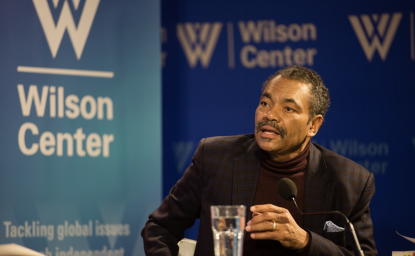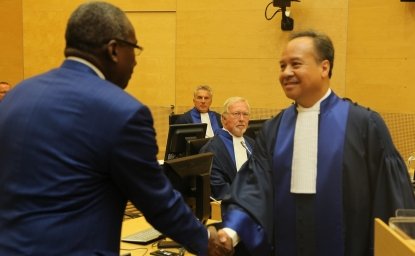
A blog of the Wilson Center
A fellow at the Polar Institute from September 2018 to August 2019, Ruslan Garipov is an Adjunct Professor at American University School of International Service. His interest and expertise are in the field of indigenous peoples’ rights. Ruslan Garipov is the author of Indigenous Peoples’ Protection in International Law (Kazan Federal University, 2012); Indigenous Peoples’ Rights Protection in Russia and the US (Tatar State University of Humanities and Education, 2010) and many articles in peer-reviewed law journals. He has been a recipient of various grants and scholarships including from the American University Washington College of Law, the Wilson Center, Fulbright; and has been a consultant at the World Bank Group and the United Nations. More information can be found on his personal website: www.ruslangaripov.com
Q&A
Q: Your research often talks about indigenous rights in Russia. Can you tell the Wilson Center audience how and why you became interested in this field of study?
A: I was born in the USSR and from my childhood I was interested in Native Americans. Partially it is because Native Americans were used by the Soviet anti-American propaganda to demonstrate an example of oppressed peoples whose cultures had been destroyed by the unstoppable and ruthless march of capitalism. For instance, the Soviet newspapers publicized the events about American Indian uprising at Wounded Knee in South Dakota in 1973 and collected signatures for a petition in support of Leonard Peltier, an Indian activist jailed for the killing of two FBI agents in 1977. American Indians’ image for use in anti-American propaganda was chosen not by accident, but as a result of accurate and deeply laid policy. This policy resulted in an interesting phenomenon in the Soviet Union that continues to persist in contemporary Russia.
I also read many books about Native Americans and wrote my high school final essay on the “Song of Hiawatha” written by famous American poet Henry Longfellow. I fell in love with Native Americans because of German writer Karl May as well. His eminent books about Apache chief Winnetou and his best friend Old Shatterhand are well-known in Eastern Europe. But my favorite books to read come from American writer James Willard Schultz who is also well-known in Russia, but not in the US. I have found myself through his love of wildlife and adventures so eloquently described in his books. My love and respect for nature came from his books as well, as he meaningfully depicted Native Americans’ peaceful and harmonious coexistence with the Mother Earth.
My passion in Native American studies brought me to the US in 2007 for the first time as a Fulbright scholar, where I spent 6 months at the Kennan Institute at the Woodrow Wilson Center. In May 2007 I visited the UN Permanent Forum on Indigenous Issues in NYC during the hot debates on the UN Declaration on the Rights of Indigenous Peoples which was lately approved by the UN General Assembly. I met aboriginal people from Russia there and became interested in indigenous peoples’ rights in Russia as well. Thus, my interest about indigenous rights in Russia was formed through my immersion into the Native Americans study after I started to attend international forums on indigenous peoples’ rights while I was in the US.
Q: What are the main problems indigenous peoples in Russia face today?
A: Indigeneity is a very important and sensitive issue in modern Russia with its multi-ethnic and multicultural nature of the nation with almost two hundred different ethnicities living within the Russian Federation. The definition of indigenous peoples in Russia has several requirements:
(1) living in the historical territories of their ancestors;
(2) preserving their traditional way of life, and occupations;
(3) recognizing themselves as a separate ethnicity;
(4) numbering at most 50,000 people within Russia.
Because of the numerical threshold, indigenous peoples in Russia are called “indigenous small-numbered peoples.” It is rather unique worldwide and creates asymmetrical legislative protection among groups who share similar challenges and characteristics but are not ultimately recognized as indigenous peoples. There is unified list of indigenous peoples in Russia, which currently enumerates a list of 47 peoples, 40 of which inhabit territories of Siberia, North and the Far East of Russia, constituting up to 0.3 percent of the Russia’s population.
Indigenous territories are strategically important for Russia’s economy, because of many natural resources located there. It is a big challenge to find a way to combine economic benefits with the preservation of unique ecosystems and indigenous communities in the North. It is, therefore, important to emphasize indigenous peoples’ connection to the land and subsistence off its natural resources. It is also important to highlight that indigenous peoples are not intrinsically vulnerable, but because of external factors brought by the modern society. Considering the climate change and industrial development in the Northern territories, many indigenous groups are now in danger of disappearing. Of all of the problems facing indigenous peoples, the most concerning is the right to their lands.
The law guarantees the right of indigenous peoples to own and use, free of charge, various categories of land required for supporting their traditional economic systems and crafts. In other words, the land is not protected just for the mere fact that indigenous peoples have been living there, but because the land is necessary for the traditional economic system of the indigenous community. There is also a contradiction with the land legislation in Russia as it provides land for rent, but not for the use free of charge as it is provided by the aboriginal legislation. This right is interpreted from the standpoint of ordinary property relations, and not from the standpoint of public law, derived from the recognition of the fact of residence of these peoples on the relevant lands since time immemorial.
In 2015 the Human Rights Committee (HRC) became concerned about the fact that insufficient measures were being taken to respect and protect the rights of indigenous peoples and to ensure that members of such peoples are recognized as indigenous. HRC was additionally concerned that no territory of traditional nature use had been established under the law on “Territories of Traditional Nature Use.” In 2017 the UN Committee on the Elimination of Racial Discrimination emphasized the failure to establish any federally protected territories of traditional nature use for indigenous peoples as well.
Indigenous peoples in Russia are still one of the most vulnerable and excluded socio-economic group of the population. Aboriginal law in Russia is unstable, contradictive, often imitational, only initially developed, and not enough adjusted to international law. A human rights-based approach and equitable dialogue between the government and indigenous peoples has mostly been absent in recent years in Russia. Indigenous peoples’ rights are considered something what is “granted” by the state and revoked again when needed. It is often when the goodwill and availability of the local executive branch of power is more important than rule of law and plays in both positive and negative terms.
Q: Your work at the Wilson Center and beyond has been critical in developing a more complete history of indigenous rights in Russia. Are there any similarities in the treatment of indigenous peoples of Russia and those in the United States?
A: Indigenous peoples share the common issues and face the same problems both in Russia and the US. The study of indigenous peoples’ rights engages with a history of grievances. There are many similarities in the treatment of Native Americans in the US and indigenous small-numbered peoples in Russia. In both countries, indigenous communities face extinction, and must put up a fight against governments and extractive businesses in order to keep their lands and their lifestyles. Take, for instance, the Standing Rock Sioux tribe in North Dakota, whose opposition to the Dakota Access Pipeline project, also known as the Bakken pipeline, captured international attention a couple years ago. The controversy prompted the largest gathering of Native Americans in years, including delegations sent by tribes indigenous to Central and South America. Within a few months, the protest turned into a movement. Thousands of Native Americans from different states joined the movement and showed their support. Various Native American nations found unity in their solidarity with the Standing Rock Sioux Tribe.
In the same time period, treatment of indigenous peoples in America has some peculiarities. When European settlers came to America, they dealt with local tribes as sovereign nations. Land purchases and guarantees of peace were handled by treaty, and since then, hundreds of treaties between tribal nations and the United States have been negotiated by Presidents and ratified by two-thirds of the Senate. From 1778 to 1871, the federal government entered more than 370 treaties with various Indian tribes. These 18th and 19th century treaties were negotiated, bilateral agreements between independent nations, and still hold legal force. That the United States recognized Indian tribes as Nations which sets tribal groups apart from other US citizens. American Indian reservations are now the only national-territorial formations in the US structure lodged with powers and sovereignty.
Today, indigenous people and their lands are faced with the dangers of alienation and cultural extinction because of the triple-threat of assimilation, climate change, and harmful extractive industries in both countries. The prosperity among indigenous communities mostly depends on how the governments embrace and protect their rights and freedoms. Communities prosper if they have institutions that protect their property and profit, and government does not interfere in their incentives, institutions, traditions and innovations.
International standards play a tremendous role in ensuring indigenous peoples’ rights in our countries nowadays. Previously, if international law could be considered an instrument of colonialism and territorial conquest, today it is an important benchmark and a powerful driver in the development of national legislation aimed at protecting the rights of indigenous peoples both in Russia and the US. It is also crucial to pay attention not only to the legal issues, but also to the anthropological and cultural problems within the study of what occurs when different cultures encounter one another and the history of migration and population, which can shed light on the disputes about primacy and ownership of the land and resources.
Q: What’s next for you? Do you have any upcoming projects or future plans you can tell us about?
A: I just came back from Pretoria, South Africa, where I reported on indigenous peoples’ land rights in Russia at the UN Expert Mechanism on the Rights of Indigenous Peoples meeting. It was a great opportunity to communicate with the like-minded people from different countries and to convey the main concerns regarding Russia’s indigenous peoples to the international community.
Right now, I am working on several papers I am going to publish in English in the short term and still waiting the results from the NY Bar exam which I have taken last July. Ideally, I would like to combine my legal practice and teaching, and I am looking forward to prospective endeavors and opportunities to promote and advance indigenous peoples’ rights either in Russia, United States or worldwide.
I am also very thankful to the Woodrow Wilson Center as my fellowship there helped me to develop a syllabus and to launch a new course on Arctic Sustainable Development and Indigenous Peoples’ Rights at American University School of International Service.
Author

Associate Professor, Kazan Federal University, Russia; Adjunct Professor, American University

Polar Institute
Since its inception in 2017, the Polar Institute has become a premier forum for discussion and policy analysis of Arctic and Antarctic issues, and is known in Washington, DC and elsewhere as the Arctic Public Square. The Institute holistically studies the central policy issues facing these regions—with an emphasis on Arctic governance, climate change, economic development, scientific research, security, and Indigenous communities—and communicates trusted analysis to policymakers and other stakeholders. Read more


Kennan Institute
After more than 50 years as a vital part of the Wilson Center legacy, the Kennan Institute has become an independent think tank. You can find the current website for the Kennan Institute at kennaninstitute.org. Please look for future announcements about partnership activities between the Wilson Center and the Kennan Institute at Wilson Center Press Room. The Kennan Institute is the premier US center for advanced research on Eurasia and the oldest and largest regional program at the Woodrow Wilson International Center for Scholars. The Kennan Institute is committed to improving American understanding of Russia, Ukraine, Central Asia, the South Caucasus, and the surrounding region through research and exchange. Read more

Explore More in Scholar & Alumni Spotlight
Browse Scholar & Alumni Spotlight
Olufemi Vaughan: Shaping Governance Through Scholarship and Dialogue

Dr. Maurice Jackson: The Sounds of Resistance Throughout History


